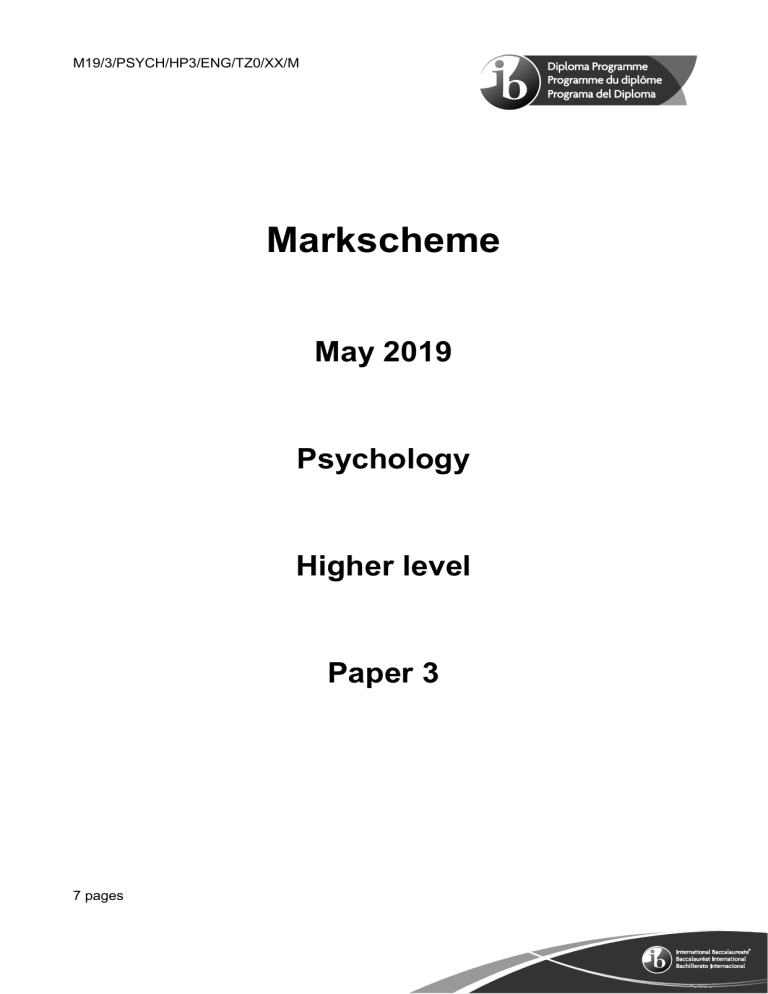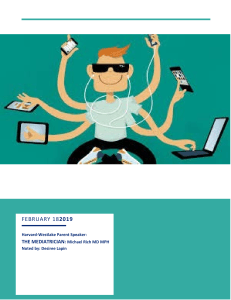
M19/3/PSYCH/HP3/ENG/TZ0/XX/M Markscheme May 2019 Psychology Higher level Paper 3 7 pages –2– M19/3/PSYCH/HP3/ENG/TZ0/XX/M No part of this product may be reproduced in any form or by any electronic or mechanical means, including information storage and retrieval systems, without written permission from the IB. Additionally, the license tied with this product prohibits commercial use of any selected files or extracts from this product. Use by third parties, including but not limited to publishers, private teachers, tutoring or study services, preparatory schools, vendors operating curriculum mapping services or teacher resource digital platforms and app developers, is not permitted and is subject to the IB’s prior written consent via a license. More information on how to request a license can be obtained from http:// www.ibo.org/contact-the-ib/media-inquiries/for-publishers/guidance-forthird-party-publishers-and-providers/how-to-apply-for-a-license. Aucune partie de ce produit ne peut être reproduite sous quelque forme ni par quelque moyen que ce soit, électronique ou mécanique, y compris des systèmes de stockage et de récupération d’informations, sans l’autorisation écrite de l’IB. De plus, la licence associée à ce produit interdit toute utilisation commerciale de tout fichier ou extrait sélectionné dans ce produit. L’utilisation par des tiers, y compris, sans toutefois s’y limiter, des éditeurs, des professeurs particuliers, des services de tutorat ou d’aide aux études, des établissements de préparation à l’enseignement supérieur, des fournisseurs de services de planification des programmes d’études, des gestionnaires de plateformes pédagogiques en ligne, et des développeurs d’applications, n’est pas autorisée et est soumise au consentement écrit préalable de l’IB par l’intermédiaire d’une licence. Pour plus d’informations sur la procédure à suivre pour demander une licence, rendez-vous à l’adresse http://www.ibo.org/fr/contact-the-ib/media-inquiries/for-publishers/ guidance-for-third-party-publishers-and-providers/how-to-apply-for-alicense. No se podrá reproducir ninguna parte de este producto de ninguna forma ni por ningún medio electrónico o mecánico, incluidos los sistemas de almacenamiento y recuperación de información, sin que medie la autorización escrita del IB. Además, la licencia vinculada a este producto prohíbe el uso con fines comerciales de todo archivo o fragmento seleccionado de este producto. El uso por parte de terceros —lo que incluye, a título enunciativo, editoriales, profesores particulares, servicios de apoyo académico o ayuda para el estudio, colegios preparatorios, desarrolladores de aplicaciones y entidades que presten servicios de planificación curricular u ofrezcan recursos para docentes mediante plataformas digitales— no está permitido y estará sujeto al otorgamiento previo de una licencia escrita por parte del IB. En este enlace encontrará más información sobre cómo solicitar una licencia: http://www.ibo.org/es/contact-the-ib/media-inquiries/for-publishers/ guidance-for-third-party-publishers-and-providers/how-to-apply-for-alicense. –3– M19/3/PSYCH/HP3/ENG/TZ0/XX/M Paper 3 markbands (for question 3) Marks 0 1–3 4–6 7–9 Level descriptor The answer does not reach a standard described by the descriptors below. The question is misunderstood and the central issue is not identified correctly, resulting in a mostly irrelevant argument. The response contains mostly inaccurate references to the approaches to research or these are irrelevant to the question. The reference to the stimulus material relies heavily on direct quotations from the text. The question is understood, but only partially answered resulting in an argument of limited scope. The response contains mostly accurate references to approaches to research which are linked explicitly to the question. The response makes appropriate but limited use of the stimulus material. The question is understood and answered in a focused and effective manner with an accurate argument that addresses the requirements of the question. The response contains accurate references to approaches to research with regard to the question, describing their strengths and limitations. The response makes effective use of the stimulus material. –4– 1. (a) M19/3/PSYCH/HP3/ENG/TZ0/XX/M Identify the research method used and outline two characteristics of the method. [3] Award [1] for stating experiment (acceptable terms: lab experiment, controlled experiment, true experiment). Stating ‘experiment’ without specification is acceptable. Award [0] for field experiment, natural experiment, quasi experiment, field study. Answers related to characteristics of the experiment may include two of the following characteristics: Award [1] per relevant point, up to a maximum of [2]. Answers that outline characteristics such as controls, cause-effect relationship, IV and DV, may be awarded marks for this even if they have not identified the research method as a lab experiment. • The lab experiment is designed to test a hypothesis (and null hypothesis). • The lab experiment involves at least two conditions, the IV (in this paper a multitasking (listening to a lecture and complete 12 online tasks) or a nonmultitasking condition) and DV (score on the test). • Controls, for example for participant variables: the participants were randomly allocated into the two conditions by assigning them to a random seat number. • The lab experiment can establish a cause-effect relationship between manipulation of the IV and its effect on the DV. The results of this experiment showed that participants in the multitasking condition scored significantly lower on the comprehension test than participants in the non-multitasking condition. • Any other relevant point. (b) Describe the sampling method used in the study. Award [1] for stating convenience (or opportunity) sampling. Self-selected sampling (or volunteer sample) is acceptable if linked to convenience (as this is specifically mentioned in the stimulus paper). Description of the sampling method may include two of the following characteristics: [1] per relevant point. Maximum of [2]. • Convenience (or opportunity) sampling is a non-probability sampling method, which means that participants are not chosen randomly. • A convenience/opportunity sample consists of participants who represent the population of interest. In the case of the study in the stimulus material, the population is university students but the topic is of general interest. • A convenience/opportunity sample consists of participants based on availability and willingness to participate. • Convenience sampling is an easy and quick way to get a sample and often used in research at universities as in this study. • A convenience/opportunity sample suffers from selection bias and is therefore not necessarily representative of the population being studied or to other populations. • Any other relevant point. [3] –5– (c) M19/3/PSYCH/HP3/ENG/TZ0/XX/M Suggest an alternative or additional research method giving one reason for your choice. Award [1] for naming an alternative or additional research method and [2] for rationale. Alternative/additional research methods that could be used to study the same topic as the experiment in the stimulus (that is, if multitasking on a laptop while listening to a lecture impairs learning) include, but are not limited to: A survey Rationales for using surveys as an additional or alternative method could include, but are not limited to: • Using a survey as alternative method with random sampling of participants would be more representative of the population and easier to generalize results. • A survey could ask students more specific questions related to multitasking, for example, how often they multitasked, or to what extent they experienced that multitasking impaired their learning, and/or the effectiveness of notetaking when they multitask, eg texting or visiting Facebook during lectures. • Data from a survey as an additional research method could be used to compare if the results of the experiment corresponded with students' own perception of a possible influence of multitasking on their learning. Students might respond that they can multitask and that their performance in class is not affected negatively. This could be compared with the result of the experiment. • The survey as an additional method would add further data into a complex problem that researchers could then decide to explore using qualitative methods • The survey enables a relatively rapid and inexpensive collection of a large amount of data. Focus group interviews Rationales for using focus group interviews as an additional or alternative method could include, but are not limited to: • Exploring the student’s own perception of the issue of multitasking in class as an additional method. The facilitator would encourage the participants to share their views and experiences on multitasking during lectures. A qualitative approach such as this would give a more subjective view on multitasking and the effects students perceive on concentration and remembering. Such data could be compared to the findings of the experiment and thus give a more holistic view of the problem of multitasking during lectures. • Data from focus groups on participants’ experiences of quality of learning during lectures with and without multitasking could give the researchers insight into aspects of the problem that they had not thought of themselves. • Data from a focus group as an alternative method could give researchers an idea of how students perceive multitasking and then use these data for further research, perhaps using an experiment. [3] –6– 2. M19/3/PSYCH/HP3/ENG/TZ0/XX/M Describe the ethical considerations that were applied in the study and explain if further ethical considerations could be applied. [6] For describing the ethical considerations that were applied in the study: [1] per relevant point made, up to a maximum of [3]. • The researchers gave the participants a consent form to sign before the start of the study, in line with ethical guidelines in psychological research. • The lecture was based on an ethically neutral (non-sensitive) topic. • The participants were debriefed after they had completed the study. Therefore participants were fully informed about the study once the experiment was completed, including how the data would be used. For explaining further ethical considerations that could be applied: [1] per relevant point made with a maximum of [3]. • Confidentiality and anonymity are important in all research. It may be difficult to ensure because students in this study sit close to one another in the simulated class setting. A way to deal with this could be to test students individually. In the context of this study it may be less important because there is not much personal information involved so it would be difficult to identify students from their data set. • Participants should be informed that they could contact the researchers if they had any questions about the study, for example if they would like to know how the data would be used. • Deception is used in the study. It must be clearly justified, for example, in a research ethics application form why (minor) deception is necessary in this particular study. • Participants should be informed of their rights to withdraw from the research once it has started, as well as consequences of doing so. In this study, that was not done. • Receiving course credit for participation in research is a common way to recruit participants at many universities. An ethical issue here is whether students feel coerced to participate. Students who do not wish to participate in this research should not be disadvantaged in any way and they should be offered a comparable alternative task to receive the same credits. • Any other relevant point(s). Answers do not need to follow the order of applied and further considerations in writing about the ethical considerations in relation to the study. Any order of mentioning the ethical considerations are valid when awarding marks. –7– 3. M19/3/PSYCH/HP3/ENG/TZ0/XX/M Discuss the possibility of generalizing/transferring the findings of the study. Refer to the paper 3 markbands on page 3 when awarding marks. Marks should be awarded according to the descriptors in the markbands. Each level of the markband corresponds to a range of marks to differentiate candidates' performance. A best-fit approach is used to ascertain which particular mark to use from the possible range for each level descriptor. The command term “discuss” requires candidates to offer a considered review that includes a range of arguments. Conclusions should be presented clearly and supported by appropriate knowledge of generalizing the findings of the study in the stimulus material. Generalization means drawing inferences from results of a study to something outside the study (external validity). The study in the stimulus is quantitative. The most appropriate model of generalization would be statistical generalization but that would require a random sample because this is typically representative of the target population. Discussion points related to the possibility of generalizing/transferring the findings of the study in the stimulus material could include, but are not limited to: • The sampling method (a convenience sample). In this study the population is university students in North America enrolled in an introductory psychology course. The study used convenience sampling and students could sign up for participation in the study or not (self-selection). This means that it is a non-probability sample rather than a random sample (probability sampling). • The sample was relatively small with only 40 participants and therefore the sample is not considered statistically representative of the population even though the researchers had recruited an even number of males and females. • The fact that students received credit for participation could also result in selection bias. When there is requirement to participate, students may be more likely to sign up for one study and not another on the basis of a convenient appointment time, rather than because they are making an informed choice about the kind of study they want to participate in. • If the researchers added more participants to the sample it would enhance the possibility of generalization, as well as adding to statistical power. The more participants, the greater the chance that differences between participants will be balanced out, and therefore generalization is more likely to happen. • If replications of this study arrived at the same conclusion (planned replication) the potential for generalization is enhanced. If the same theory of cause-effect relationship between multitasking and lowered performance found support in additional studies it would be more likely to confirm validity of the original findings. The result of this experiment has been supported by previous research and this indicates some external validity of the findings. Candidates who use the terms generalization and transferability interchangeably should not be penalized. [9]



